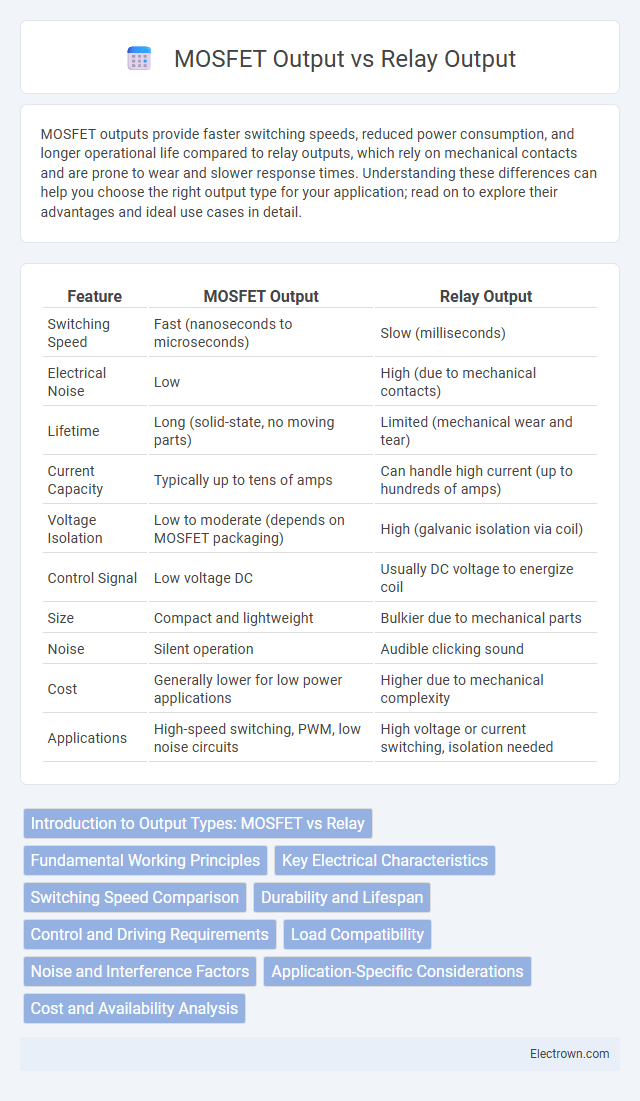MOSFET outputs provide faster switching speeds, reduced power consumption, and longer operational life compared to relay outputs, which rely on mechanical contacts and are prone to wear and slower response times. Understanding these differences can help you choose the right output type for your application; read on to explore their advantages and ideal use cases in detail.
Table of Comparison
| Feature | MOSFET Output | Relay Output |
|---|---|---|
| Switching Speed | Fast (nanoseconds to microseconds) | Slow (milliseconds) |
| Electrical Noise | Low | High (due to mechanical contacts) |
| Lifetime | Long (solid-state, no moving parts) | Limited (mechanical wear and tear) |
| Current Capacity | Typically up to tens of amps | Can handle high current (up to hundreds of amps) |
| Voltage Isolation | Low to moderate (depends on MOSFET packaging) | High (galvanic isolation via coil) |
| Control Signal | Low voltage DC | Usually DC voltage to energize coil |
| Size | Compact and lightweight | Bulkier due to mechanical parts |
| Noise | Silent operation | Audible clicking sound |
| Cost | Generally lower for low power applications | Higher due to mechanical complexity |
| Applications | High-speed switching, PWM, low noise circuits | High voltage or current switching, isolation needed |
Introduction to Output Types: MOSFET vs Relay
MOSFET outputs provide fast switching, low power consumption, and silent operation, making them ideal for high-frequency applications and solid-state circuits. Relay outputs offer galvanic isolation and can handle higher voltages and currents with mechanical durability, suitable for switching AC loads or heavy electrical equipment. Choosing between MOSFET and relay outputs depends on factors like switching speed, load type, electrical isolation, and longevity requirements.
Fundamental Working Principles
MOSFET output relies on semiconductor switching technology using a voltage-controlled field-effect transistor to enable fast, silent, and efficient current flow with minimal power loss. Relay output operates through an electromechanical switch that physically opens or closes contacts to control high-voltage circuits, providing galvanic isolation between control and load. MOSFETs excel in high-speed switching and longevity, while relays offer robustness and the ability to switch higher voltages and currents without electronic interference.
Key Electrical Characteristics
MOSFET output devices typically feature low on-resistance, fast switching speeds, and high efficiency, enabling precise control of current with minimal power loss. Relay outputs provide galvanic isolation and can handle higher voltage/current loads but suffer from slower switching times and mechanical wear. Key electrical characteristics favor MOSFETs for low-voltage, fast-switching applications, whereas relays excel in high-voltage, high-current, and electrically isolated environments.
Switching Speed Comparison
MOSFET output modules exhibit significantly faster switching speeds than relay outputs, typically operating in microseconds compared to milliseconds for relays. This rapid switching capability makes MOSFETs ideal for high-frequency applications requiring precise timing and reduced signal distortion. Relays, though slower due to mechanical contacts, offer galvanic isolation and are better suited for switching higher voltages and currents in low-frequency or on/off control scenarios.
Durability and Lifespan
MOSFET output devices exhibit superior durability and lifespan compared to relay outputs due to their solid-state design, which eliminates mechanical wear and contact degradation. Relays contain moving parts that are prone to mechanical fatigue and contact erosion, typically resulting in a limited operational lifecycle ranging from 10^4 to 10^6 switching cycles. MOSFET outputs can achieve switching cycles in the order of 10^8 or higher, making them ideal for applications requiring high reliability and extended service intervals.
Control and Driving Requirements
MOSFET outputs require low voltage and current for control, making them ideal for direct interfacing with microcontrollers and low-power circuits. Relay outputs need higher driving current and voltage due to their electromagnetic coil, often necessitating additional driver components like transistors or optocouplers. Your choice depends on the available control signal strength and the specific driving requirements of your application.
Load Compatibility
MOSFET output is ideal for switching low voltage DC loads and provides faster, silent operation with high efficiency and long lifespan, making it suitable for sensitive electronic circuits and microcontroller projects. Relay output excels in handling higher voltage AC and DC loads with electrical isolation, protecting your control system from voltage spikes and enabling compatibility with inductive or heavy-duty devices. Your choice hinges on the load type--select MOSFETs for compact, low-power applications and relays for robust, high-power or AC load switching.
Noise and Interference Factors
MOSFET outputs generate less electrical noise and are less susceptible to interference due to their solid-state design, which avoids mechanical contacts found in relay outputs. Relay outputs can produce switching noise and electromagnetic interference (EMI) because of contact arcing and coil inductance during operation. Choosing a MOSFET output can help reduce noise-related issues in sensitive electronic environments, enhancing the reliability of Your control system.
Application-Specific Considerations
MOSFET output modules excel in high-speed switching and precise control, making them ideal for applications requiring rapid on/off cycles or PWM signals, such as motor drives and solid-state relays. Relay output modules offer robust electrical isolation and can handle high voltage or current loads directly, which suits applications like heavy machinery control or switching inductive loads. Your choice should consider factors like switching frequency, load type, and electrical isolation needs to ensure optimal performance and longevity.
Cost and Availability Analysis
MOSFET outputs generally offer a lower cost solution due to fewer mechanical components and widespread semiconductor manufacturing, making them highly available in various voltage and current ratings. Relay outputs tend to be more expensive because of their electromechanical construction and limited manufacturer options, which can affect supply consistency. In terms of availability, MOSFET outputs are more readily stocked and produced in high volumes, ensuring easier procurement for most industrial and consumer electronics applications.
MOSFET output vs Relay output Infographic

 electrown.com
electrown.com